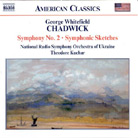July 2005
The annotation included with this CD refers to parts of Chadwick’s Second Symphony as being "Dvorák-flavored.” Similarities between these two composers are always being noted, the general assumption being that the American admired the Czech master enough to imitate him. The Second Symphony has its scherzo before the slow movement, but is otherwise full of resemblances to the New World -- in its overall character and orchestral coloring, in the prominence of certain instruments, and even in the shape of its themes. But the Chadwick work, as in some other instances of near parallel, actually came several years before the one by Dvorák. The Second Symphony was quite new and was still being performed when Dvorák arrived in New York in 1892. In the following year, in fact, he presented a prize to Chadwick for the latter’s Third Symphony. Neither of these composers imitated the other, of course. They simply developed, independently, a somewhat similar character in their warm-hearted, solidly constructed, wholly original music. There is perhaps nothing quite as effective as the two works offered here to remind us that music of substance and originality was being composed in America before the birth of such figures as Copland, Gershwin and Barber, and even before the young Charles Ives set a note on paper. There have been some memorable recordings of these two works, starting with the Howard Hanson of the Symphonic Sketches, which Mercury included among its Living Presence reissues on CD. José Serebrier included the work in the first of his two Chadwick collections for Reference Recordings, with the Czech State Philharmonic. Julius Hegyi had the Albany SO in great shape on a New World CD of the Second Symphony. Chandos gave us the two works together (as on this new Naxos issue), with Neeme Järvi conducting the Detroit SO. It’s too bad Serebrier didn’t get around to the Second Symphony: the orchestra he used -- based in Brno, the hometown of Chadwick’s exact contemporary Leoš Janácek -- may have responded instinctively to the “Dvorák-flavored” material, while definitely responding to Serebrier’s sympathetic grasp of it. The new issue from Naxos, it must be admitted, is not quite in the class of these earlier issues, particularly with respect to the sound quality. But Theodore Kuchar’s sympathetic grasp of both works is beyond question, the Naxos price is less than half that of the similar coupling on Chandos, and the new issue is easy to find as well as economical. It may be recommended, then, as a good low-risk introduction to this music for listeners who have yet to discover it. Those who decide later to move up to Serebrier, Hanson, Hegyi and/or Järvi are not likely to regard this as a bad investment. GO BACK TO: |
 Chadwick - Symphony No. 2;
Symphonic Sketches
Chadwick - Symphony No. 2;
Symphonic Sketches